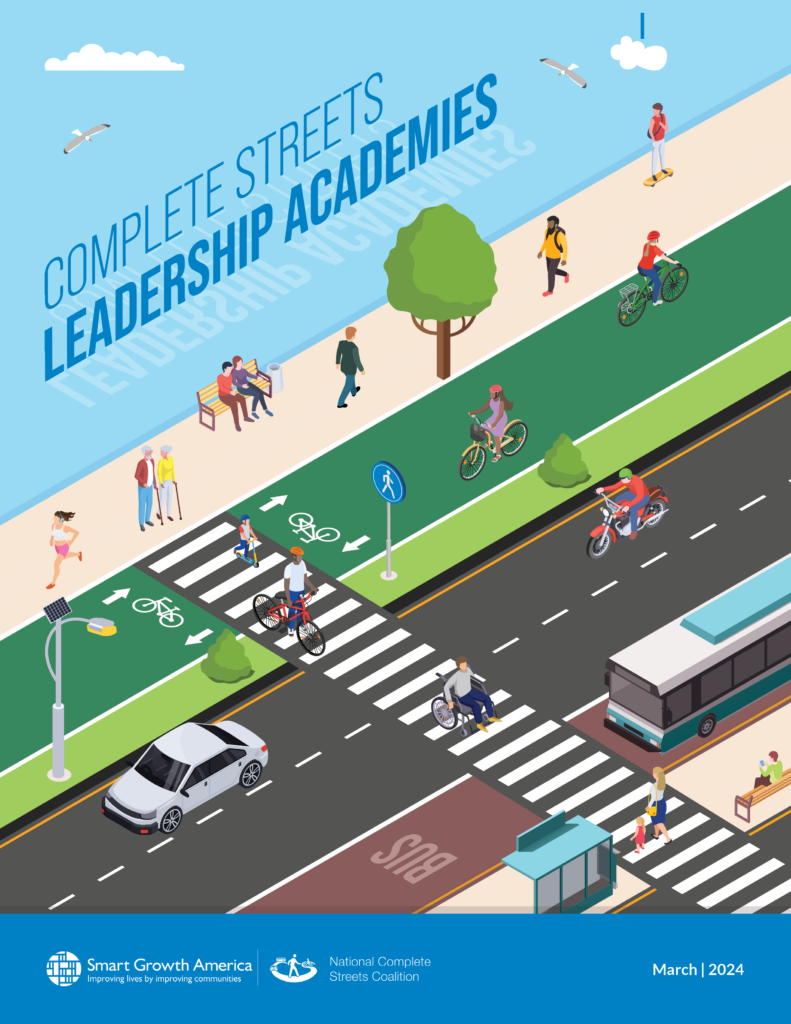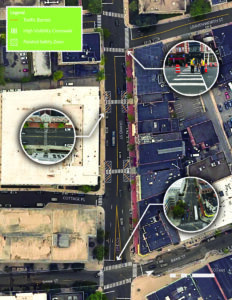Over the years, the City of Waterbury has worked to revitalize its downtown and implement its 2014 Complete Streets Resolution. Participating in the Complete Streets Leadership Academy gave Waterbury the dedicated time to focus on addressing problems related to the safety and accessibility of people walking and biking. Read the full case study in the Complete Streets Leadership Academies Report and explore the other case studies here.
Project Snapshot
The participants from Waterbury identified Grand Street as the project location because it is a major commercial, residential, and civic corridor in the heart of downtown which also connects to a number of interstates. The Complete Streets Leadership Academy allowed Waterbury to dedicate time to demonstrate the value of using a holistic approach that considers all modes of transportation including walking, rolling, biking, and public transit use. It was an opportunity to reimagine what a main street could look like that serves residents, encourages visitors, and protects the interstate travel the area supports.
The implemented quick-build demonstration aimed to address unsafe vehicle speeds, long pedestrian crossings, and crosswalks that lack visibility, all of which put pedestrians at high risk. Additionally, the project sought to draw the community to the area, giving businesses and the economy overall a boost and making the main street a hub again.
The Waterbury project shortened the crossing distance for pedestrians, narrowing travel lanes to 11.5’, and providing at least 25’ of no parking area on both sides of the crosswalks to improve visibility at intersections. Waterbury used barrels, traffic cones, and other easily moved materials to narrow lanes and improve crossing protection. They also increased the visibility of existing crosswalks with temporary paint and tape.
Outcomes
The impact of the project was measured through observations, data collection, and engagement. Highlights include:
- Data collected in August 2023 demonstrated an 11 percent decrease in speeds from similar data collected in April 2023. Data collected after the project was removed showed an increase in vehicle speeds, further demonstrating the impact of the decrease in lane width on driver behavior.
- Program participants noted an increased knowledge in how to balance vehicular traffic with active transportation, including the logistical issues that need to be navigated in order to ensure success.
Key Takeaways
Partnerships can help overcome internal barriers. Waterbury faced internal staffing and resources challenges early on. By engaging the Naugatuck Valley Council of Governments (NVCOG), they were able to build capacity and successfully complete the project. This effort also brought in other partners who could be part of future efforts for permanent changes to the area.
Early communication and engagement is key. Local businesses were concerned about the impact of removing parking spots. The team knew that it was key to engage businesses early in the project. Multiple forms of communication, including an in-person activity, demonstrated the need and potential of the proposed changes.
Data can tell a story. Numbers don’t lie, and the early success in reducing speeds contributed to the narrative of the project. Capturing before and after data is critical to being able to make the case that the project was successful and to inspire future action.
 In 2022, Smart Growth America launched the Complete Streets Leadership Academies in Alaska, California, Connecticut, and Tennessee to equip and train local agencies and state departments of transportation to collaborate, innovate, and commit to making changes together to address safety on these dangerous state-owned roads. Cohorts were selected to plan and implement “quick-build” demonstration projects, a way to pilot and test new ideas and street designs to activate streets and better support walking, biking, and rolling.
In 2022, Smart Growth America launched the Complete Streets Leadership Academies in Alaska, California, Connecticut, and Tennessee to equip and train local agencies and state departments of transportation to collaborate, innovate, and commit to making changes together to address safety on these dangerous state-owned roads. Cohorts were selected to plan and implement “quick-build” demonstration projects, a way to pilot and test new ideas and street designs to activate streets and better support walking, biking, and rolling.This program and report was developed with funding from the Centers for Disease Control and Prevention’s (CDC) Division of Nutrition, Physical Activity, and Obesity (Cooperative Agreement CDC-RFA-OT18-1802). The views presented in this product do not necessarily reflect the views and/or positions of CDC.
